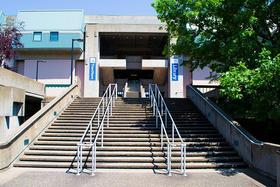- Highland Community College, the first college in Kansas, provides lifelong learning opportunities and contributes to economic development to enhance the quality of life in the communities we serve. The college also exists to serve each student. It provides educational leadership to help each individual become a well-informed, responsible citizen and a productive member of society. The most important people in ensuring the quality of your academic life at HCC are the faculty. Just as they are prepared to assist you in the classroom with quality instruction, they will also be involved with you outside the classroom as advisors, intramural opponents, and friends. Get to know them. They are looking forward to working with you to meet your educational goals. Highland Community College is accredited by the North Central Association of Colleges and Schools.
School Highlights
Northeast Kansas Technical Center serves 289 students
Minority enrollment is 100% of the student body (majority Black and Hispanic), which is less than the state average of 40%.
Quick Facts (2025-26)
- Enrollment: 289 students
- Acceptance Rate: 75%
- Source: Integrated Postsecondary Education Data System (IPEDS)
Top Rankings
Northeast Kansas Technical Center ranks among the top 20% of public schools in Kansas for:
Category
Attribute
School Overview
Northeast Kansas Technical Center
(KS) Community College Avg.
Carnegie Classification
Associates--Public Rural-serving Small
Associate's Colleges: Mixed Transfer/Career & Technical-High Nontraditional
Institution Level
At least 2 years but < 4 years
At least 2 but less than 4 years
Institution Control
Public
Public
Total Faculty
n/a
155 staff
School Calendar
Student Body
The student population of Northeast Kansas Technical Center has stayed relatively flat over five years.
The Northeast Kansas Technical Center diversity score of 0.00 is less than the state average of 0.60. The school's diversity has stayed relatively flat over five years.
Total Enrollment
289 students
2,057 students
Student-Teacher Ratio
n/a
16:1
# Full-Time Students
n/a
606 students
# Part-Time Students
n/a
1,451 students
# Enrollment Undergraduate
n/a
229 students
# Full-Time Undergraduate Students
150 students
569 students
# Full-Time Graduate Students
n/a
11 students
# Part-Time Undergraduate Students
139 students
1,424 students
# Part-Time Graduate Students
n/a
5 students
Total Dormitory Capacity
n/a
342 students
% American Indian/Alaskan
n/a
1%
% Asian
n/a
3%
% Hispanic
n/a
15%
% Black
n/a
8%
% White
n/a
60%
% Hawaiian
n/a
1%
% Two or more races
n/a
4%
% Non Resident races
n/a
2%
% Unknown races
100%
6%
Diversity Score
n/a
0.60
College Completion Rate (Students who graduate in less than 4 years)
n/a
41%
College Completion Rate (Students who graduate in 4 years or more than 4 years)
n/a
31%
Tuition and Acceptance Rate
% Students Receiving Some Financial Aid
90%
90%
Median Debt for Graduates
n/a
$8,892
Median Debt for Dropouts
n/a
$5,467
Acceptance Rate
75%
100%
ACT Composite
n/a
21
Source: 2023 (or latest year available) Integrated Postsecondary Education Data System (IPEDS)
Frequently Asked Questions
What is the acceptance rate of Northeast Kansas Technical Center?
The acceptance rate of Northeast Kansas Technical Center is 75%, which is lower than the state average of 100%.
What is Northeast Kansas Technical Center's ranking?
Northeast Kansas Technical Center ranks among the top 20% of community college in Kansas for: Average community college minority breakdown.
Recent Articles

The Rise of Technical and Vocational Training in 2025
Explore the 2025 surge in technical and vocational training—enrollment, policy, costs, and why this path is gaining ground for students and parents.

Stackable Credentials: How Community Colleges Advance Careers
Discover how community colleges use stackable credentials to build career pathways, boost earnings, and enable lifelong learning in 2025.

High-Paying Jobs You Can Get with a Community College Degree
Discover top high-paying careers you can launch in 2025 with a community college (associate) degree and high-growth credentials in tech, healthcare and trades.





